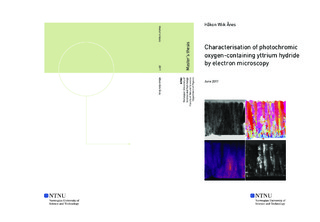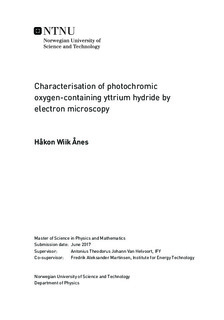| dc.contributor.advisor | Van Helvoort, Antonius Theodorus Johann | |
| dc.contributor.advisor | Martinsen, Fredrik Aleksander | |
| dc.contributor.author | Ånes, Håkon Wiik | |
| dc.date.accessioned | 2017-10-02T14:00:47Z | |
| dc.date.available | 2017-10-02T14:00:47Z | |
| dc.date.created | 2017-06-19 | |
| dc.date.issued | 2017 | |
| dc.identifier | ntnudaim:16467 | |
| dc.identifier.uri | http://hdl.handle.net/11250/2457805 | |
| dc.description.abstract | Smart windows based on chromogenic materials have in recent years emerged as promising candidates for the next generation of energy-efficient windows. One group of chromogenic materials are photochromic, which are characterised by their ability to change their optical properties reversibly when exposed to light. They can thus be used in the fabrication of windows with dynamic control of solar energy. A photochromic oxygen-containing yttrium hydride (YHO) thin film is an attractive candidate for use in smart windows, but its detailed morphology and the development of the crystal structure, texture and oxygen concentration with film thickness are largely unknown.
YHO thin films with thicknesses of 100 nm and 650 nm were synthesised by reactive magnetron sputtering deposition on silicon and gallium arsenide substrates. SEM studies were done on film fragments dispersed on copper grids with carbon film. Plan-view and cross-section specimens for TEM studies were prepared by ultramicrotomy and tripod polishing. The specimens were studied using scanning precession and selected-area electron diffraction, bright-field and dark-field imaging, high resolution TEM, energy-filtered TEM and scanning TEM in combination with energy dispersive X-ray spectroscopy. The sets of scanning precession electron diffraction data were analysed using automated crystal orientation mapping and multivariate statistical analysis.
The films were found to have an expanded YH2 fcc structure with a lattice parameter of 5.39 Å. Evidence of one or more additional crystalline phases in the film were found in diffraction experiments, however they were not identified. The microstructure of the films is dominated by a column growth, resembling zone T in the structure zone model for sputtering deposited thin films. The columns consist of multiple grains with an average grain size of 15 nm. The oxygen concentration was found to be highest in the film bottom and decreasing towards the top surface. This variation is attributed to a variation in the surface area of the structure from largest in the bottom due to smaller structures and smallest in the top due to expanding column growth structures. The crystal texture in the growth direction went from a weak [111] texture in the bottom, to a competitive growth with no texture in the lower middle, to finally a near unique [001] texture from the middle and towards the surface. The [001] texture dominates the microstructure. | |
| dc.language | eng | |
| dc.publisher | NTNU | |
| dc.subject | Fysikk og matematikk, Teknisk fysikk | |
| dc.title | Characterisation of photochromic oxygen-containing yttrium hydride by electron microscopy | |
| dc.type | Master thesis | |

